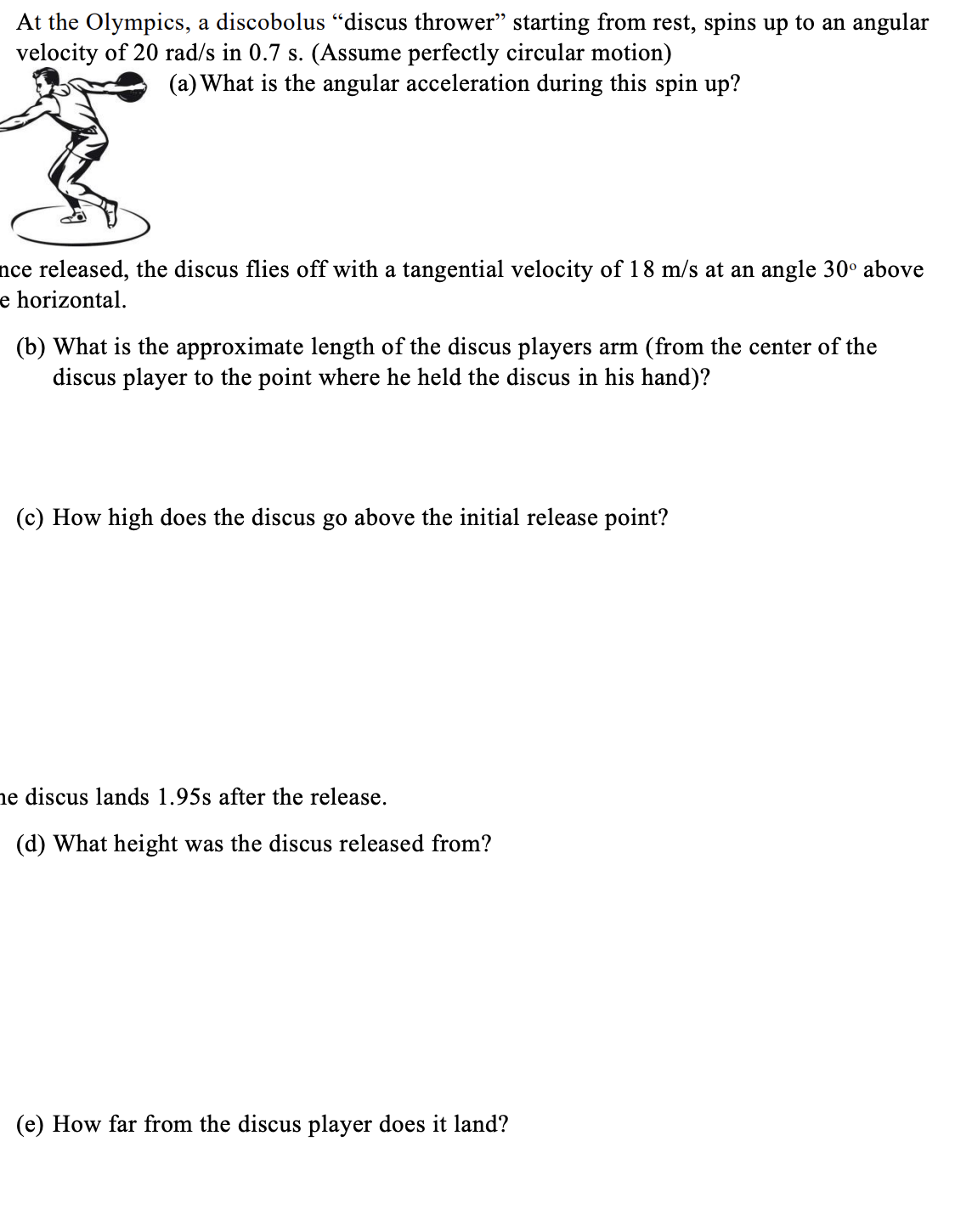At the Olympics, a discobolus “discus thrower" starting from rest, spins up to an angular velocity of 20 rad/s in 0.7 s. (Assume perfectly circular motion) (a) What is the angular acceleration during this spin up? ce released, the discus flies off with a tangential velocity of 18 m/s at an angle 30° above horizontal. (b) What is the approximate length of the discus players arm (from the center of the discus player to the point where he held the discus in his hand)? (c) How high does the discus go above the initial release point? e discus lands 1.95s after the release. (d) What height was the discus released from? (e) How far from the discus player does it land?
At the Olympics, a discobolus “discus thrower" starting from rest, spins up to an angular velocity of 20 rad/s in 0.7 s. (Assume perfectly circular motion) (a) What is the angular acceleration during this spin up? ce released, the discus flies off with a tangential velocity of 18 m/s at an angle 30° above horizontal. (b) What is the approximate length of the discus players arm (from the center of the discus player to the point where he held the discus in his hand)? (c) How high does the discus go above the initial release point? e discus lands 1.95s after the release. (d) What height was the discus released from? (e) How far from the discus player does it land?
University Physics Volume 1
18th Edition
ISBN:9781938168277
Author:William Moebs, Samuel J. Ling, Jeff Sanny
Publisher:William Moebs, Samuel J. Ling, Jeff Sanny
Chapter10: Fixed-axis Rotation
Section: Chapter Questions
Problem 10.1CYU: Check Your Understanding The fan blades on a turbofan jet engine (shown below) accelerate from rest...
Related questions
Question
Need help with part d and e. Preferably as soon as possible

Transcribed Image Text:At the Olympics, a discobolus “discus thrower" starting from rest, spins up to an angular
velocity of 20 rad/s in 0.7 s. (Assume perfectly circular motion)
(a) What is the angular acceleration during this spin up?
nce released, the discus flies off with a tangential velocity of 18 m/s at an angle 30° above
e horizontal.
(b) What is the approximate length of the discus players arm (from the center of the
discus player to the point where he held the discus in his hand)?
(c) How high does the discus go above the initial release point?
he discus lands 1.95s after the release.
(d) What height was the discus released from?
(e) How far from the discus player does it land?
Expert Solution
This question has been solved!
Explore an expertly crafted, step-by-step solution for a thorough understanding of key concepts.
This is a popular solution!
Trending now
This is a popular solution!
Step by step
Solved in 2 steps

Knowledge Booster
Learn more about
Need a deep-dive on the concept behind this application? Look no further. Learn more about this topic, physics and related others by exploring similar questions and additional content below.Recommended textbooks for you

University Physics Volume 1
Physics
ISBN:
9781938168277
Author:
William Moebs, Samuel J. Ling, Jeff Sanny
Publisher:
OpenStax - Rice University

Glencoe Physics: Principles and Problems, Student…
Physics
ISBN:
9780078807213
Author:
Paul W. Zitzewitz
Publisher:
Glencoe/McGraw-Hill

Principles of Physics: A Calculus-Based Text
Physics
ISBN:
9781133104261
Author:
Raymond A. Serway, John W. Jewett
Publisher:
Cengage Learning

University Physics Volume 1
Physics
ISBN:
9781938168277
Author:
William Moebs, Samuel J. Ling, Jeff Sanny
Publisher:
OpenStax - Rice University

Glencoe Physics: Principles and Problems, Student…
Physics
ISBN:
9780078807213
Author:
Paul W. Zitzewitz
Publisher:
Glencoe/McGraw-Hill

Principles of Physics: A Calculus-Based Text
Physics
ISBN:
9781133104261
Author:
Raymond A. Serway, John W. Jewett
Publisher:
Cengage Learning

Physics for Scientists and Engineers: Foundations…
Physics
ISBN:
9781133939146
Author:
Katz, Debora M.
Publisher:
Cengage Learning